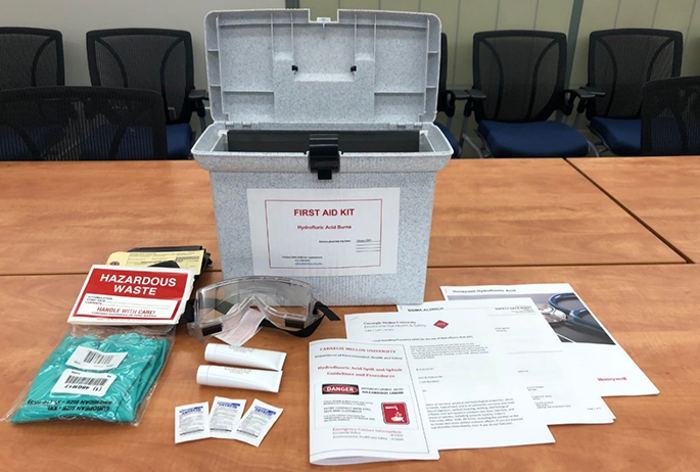Chemical Safety
Chemicals, including hazardous chemicals, are used in a wide variety of operations and activities at Carnegie Mellon. Health and physical hazards pose potential risks in many of the chemicals used daily. The Chemical Safety program helps to address proper use, handling, and storage of these materials. These activities are essential to a safe working environment.
Laboratory Safety Committee (LSC)
The Laboratory Safety Committee (LSC) is comprised of representatives from Biological Sciences, Biomedical & Chemical Engineering, Chemistry, Civil & Environmental Engineering, Electrical & Computer Engineering, ICES, Materials Science & Engineering, Mechanical Engineering, Molecular Biosensor & Imaging Center, Physics and Graduate Student Representatives.
Services
Additional Resources
Chemical Hygiene Plan
OSHA’s Occupational Exposure to Hazardous Chemicals in Laboratories standard (29 CFR 1910.1450), referred to as the Laboratory standard, specifies the mandatory requirements of a Chemical Hygiene Plan (CHP) to protect laboratory workers from harm due to hazardous chemicals. The CHP is a written program stating the policies, procedures and responsibilities that protect workers from the health hazards associated with the hazardous chemicals used in that particular workplace. Required elements of the CHP include:
- Standard Operating Procedures relevant to safety & health when working with hazardous chemicals
- Controls for the protection of workers such as Engineering, Administrative and Personal Protective Equipment.
- Ensure Controls are properly working and fitted to the worker’s needs
- Provide information about the Lab Standard & CHP such as; Permissible Exposure Limits, Signs & Symptoms of Exposure, Safety Data Sheets, Training and Refresher Training
- Requirements for prior approvals of certain chemicals, or experiments
- Designation of a Chemical Hygiene Committee or Lab Safety Committee (LSC) and Chemical Hygiene Officer (CHO)
- Note: the CHO is a specialist focused on the Laboratory Standard and acts as the workers ‘Safety Liaison’
- Provisions for working with Particularly Hazardous Substances (PHS) such as Identification, Evaluation and Control of risks for using PHS
- Annual review of the CHP
- Exposure Monitoring and Medical Consultation for workers exposed to hazardous chemicals
Compliance Standards
Laboratory: OSHA Lab Standard
The use of hazardous materials in laboratory areas is addressed by the OSHA Laboratory Standard "Occupational Exposure to Hazardous Chemicals in Laboratories." This standard mandates the preparation of a Chemical Hygiene Plan consisting of specific policies and procedures addressing the requirements of the regulation.
Exposure to Hazardous Chemicals in Laboratories (Lab Standard), as found in 29 CFR 1910.1450
Non Laboratory Areas: Hazard Communication Standard
Employees who use hazardous materials in non-laboratory settings at the university are covered by the Occupational Safety and Health Administration (OSHA) Hazard Communication Standard. In addition you may wish to review Carnegie Mellon's Hazard Communication written procedures.
Hydrofluoric (HF) Safety Program
Environmental, Health and Safety is rolling out a new safety program for the labs who use or store Hydrofluoric acid (HF). All the users and lab members, where HF is present, should be aware of the hazards, safety precautions, emergency/spill response and complete the HF safety training. EHS also provide the HF First-aid/Spill kit (including calcium gluconate) to the laboratory.
Hydrofluoric acid (HF) is especially hazardous due to its high level of toxicity. In addition to causing severe chemical burns to tissue, it’s especially serious in that it can cause toxic systemic effects. Fluorides are easily absorbed through the skin, cause death of soft tissue and erode bone as well can cause cardiac arrhythmias or cardiac arrest. Acute effects of hydrofluoric acid exposure include extreme respiratory irritation, immediate and severe eye damage and pulmonary edema. Skin, eye, or lung exposure to concentrated (>50%) hydrofluoric acid solutions will cause immediate, severe, penetrating burns. Exposure to less concentrated solutions may have equally serious effects, but the appearance of symptoms can be delayed for up to 24 hours. This delayed toxic effect makes it particularly dangerous.
 Users and even the members of labs with of Hydrofluoric acid must adhere to this program, which includes:
Users and even the members of labs with of Hydrofluoric acid must adhere to this program, which includes:
- Hydrofluoric Acid Safety Training
- Standard Operating Procedure for HF use
- Emergency and Spill Response
For more information or any questions, please contact Environmental, Health and Safety at safety@andrew.cmu.edu
Labeling Requirements
The US Occupational Safety and Health Administration has specified requirements for chemical container labels. All manufacturers of products with hazardous constituents must provide a “Globally Harmonized System” (GHS) compliant label on the container. For chemicals purchased and put into service PRIOR to the adoption of the GHS, the GHS requirements are not applicable.
For Laboratories (Laboratory Safety Standard)
Although, it has NOT YET been determined whether secondary container requirement applies, here at Carnegie Mellon it is STRONGLY recommended. At a minimum, all containers in a lab setting MUST be labeled with at least the contents of the container.
For Non-lab Work Areas (Hazard Communication Standard)
Hazardous material is to be placed in a secondary container (such as for a smaller, handier container, or a dilution or mixture of the material). That secondary container needs a GHS-compliant label.
Personal Protective Equipment (PPE)

A critical aspect of working safely with hazardous materials is the proper selection and use of personal protective equipment (PPE). All PPE should be carefully selected to ensure that it is appropriate for the hazards present and that the users will be able to perform their work in reasonable comfort wearing the protective equipment.
Lithium Ion Battery Safety
Lithium batteries have become the industry standard rechargeable storage device. They are very commonly used for University operations and have several research applications. They are often chosen by researchers since they are light weight, have a higher energy density, low memory effect, and longer life span. Higher energy and higher use lead to higher risk. Due to the flammable nature of the electrolyte in these batteries, lithium-ion battery fires and accidents are on the rise. There have been several reported incidents related to batteries left on chargers for extended times, unattended charging, incompatible chargers, and shorts from improperly wired or isolated connections.
 EHS recommends faculty, staff, and students to take precautions to help prevent fire, injury, and loss of intellectual and other property. The best practices to correctly and safely use the batteries to help reduce the possibility of a reaction, fire or explosion when handling, charging, storing or disposing of lithium-ion batteries are explained in the Lithium Battery Safety Guideline.
EHS recommends faculty, staff, and students to take precautions to help prevent fire, injury, and loss of intellectual and other property. The best practices to correctly and safely use the batteries to help reduce the possibility of a reaction, fire or explosion when handling, charging, storing or disposing of lithium-ion batteries are explained in the Lithium Battery Safety Guideline.
Safety Data Sheets (SDS)
Under the Globally Harmonized System (GHS), Material Safety Data Sheets (MSDS) are now known as Safety Data Sheets (SDS).
All persons working with hazardous materials must have easy access to the SDS for the materials they work with. Carnegie Mellon allows those responsible (supervisor, researcher or instructor) for a given work area to meet this requirement in two different fashions:
- The SDS may be present in paper form in the work area, where all applicable persons have access to them.
- The SDS may be accessed through the internet via VelocityEHS, PROVIDED that it has been confirmed that SDS for all materials are available in this fashion AND that all applicable employees have access to the internet and are able to obtain SDS in this way.
3D Printer Guideline Information
While desktop 3D printers have made rapid prototyping and small-scale manufacturing easier and more accessible, they are not without their hazards. In some 3D printing processes, thermoplastics are heated, nozzle-extruded and then deposited onto a surface to build the object. As a by-product of the process, nanoparticles (ultrafine particles, or UFP’s, less than 1/10,000 of a millimeter) are emitted. For a 3D printer that uses a low-temperature polylactic acid (PLA) feedstock, 20 billion particles per minute can be released, while a higher temperature acrylonitrile butadiene styrene (ABS) feedstock can release 200 billion. Nanoparticles are of concern because they are very small and can interact with bodily systems, including the skin, lungs and nervous tissues. Exposures to nanoparticles at high concentrations have been associated with adverse health effects, including cardio-respiratory mortality, strokes and asthma symptoms. Since most 3D printers do not have exhaust ventilation or filtration accessories, placement of the printer and selection of printing materials must both be carefully considered. Contact EHS for a risk assessment.


